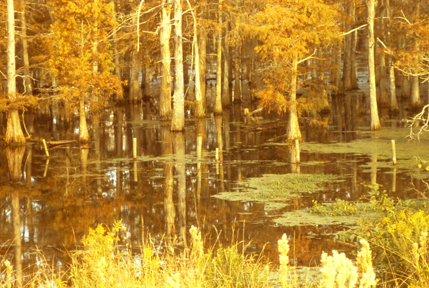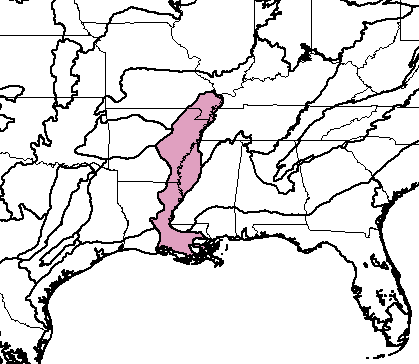
Taxodium distichum (bald cypress) swamp, Louisiana (c) 2001 Maurice J. Kaufmann
Bioimages home (click on an image to enlarge)
view
this page in its intended navigation context
Mississippi Lowland Forests
(WWF
ecoregion NA0409)

Taxodium distichum (bald cypress) swamp, Louisiana
(c) 2001
Maurice J. Kaufmann

Source of bioregions data:
Olson, D. M. and
E. Dinerstein. The Global 200: Priority ecoregions for global conservation. (PDF
file) Annals of the Missouri Botanical Garden 89:125-126.
Distinctiveness (1=highest,4=lowest): 3 (bioregionally
outstanding)
This ecoregion is part of an important migratory bird flyway. Bottomland
hardwood forests were among the most interesting ecological communities in U.S.,
but nearly all in this region were destroyed.*
Conservation Status (1=most endangered, 5=most
intact): 1 (critical)
About 5-9% of the habitat is not converted to agriculture and other uses.
Blocks of remaining habitat are in the wettest sites and are not representative
of the ecoregion's major habitats. Remaining blocks of habitat are
fragmented and threatened by alteration of river flow and logging.*

Mississippi River,
Meeman-Shelby State Park, Memphis, Tennessee (c) 2005 Steven J. Baskauf
hires



 Taxodium
distichum (bald cypress)
Taxodium
distichum (bald cypress) Cephalanthus occidentalis
(common buttonbush)
Cephalanthus occidentalis
(common buttonbush) Salix nigra (black willow)
Salix nigra (black willow) Acer
rubrum (red maple)
Acer
rubrum (red maple) Fraxinus
pennsylvanica (green ash)
Fraxinus
pennsylvanica (green ash)
 Packera glabella
(butterweed)
Packera glabella
(butterweed) Impatiens capensis
(jewelweed)
Impatiens capensis
(jewelweed)



 Liquidambar
styraciflua
Liquidambar
styraciflua Platanus
occidentalis
Platanus
occidentalis

 Smilax spp.
(green briar)
Smilax spp.
(green briar)
* Ricketts, T.H., E. Dinerstein, D.M. Olson, C.J. Loucks, et al. (1999) Terrestrial Ecoregions of North America: A Conservation Assessment. World Wildlife Fund - United States and Canada. Island Press, Washington, D.C. pp. 194-195.
Except as noted, images copyright 2002-2004 Steve Baskauf - Terms of use